Bell peppers, with their vibrant colors and sweet, crisp taste, are a must-have in any vegetable garden.
These versatile veggies not only add a splash of color to your garden but also to your culinary creations. Whether you’re whipping up a salad, grilling, or stuffing them, bell peppers bring a unique flavor and nutritional boost to your table.
As an experienced gardening enthusiast, I’m excited to share my insights on growing and caring for these delightful plants.
Benefits of Growing Bell Peppers
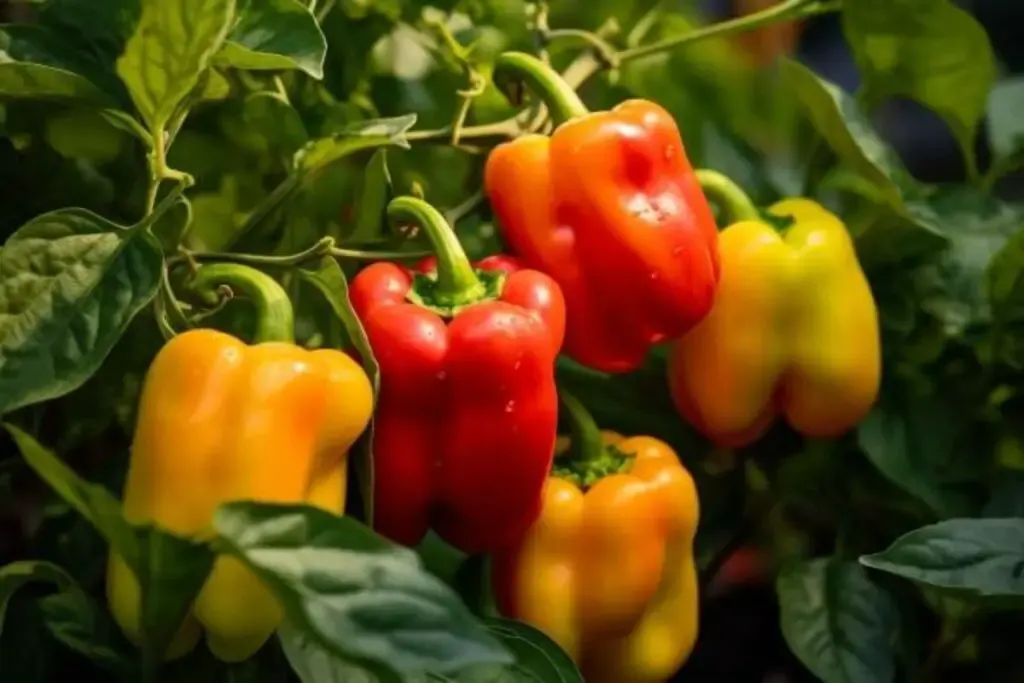
1. Nutritional Value
Bell peppers are a health powerhouse. They’re rich in vitamins A and C, potassium, and fiber, making them an excellent addition to a healthy diet.
2. Versatility in Cooking
Bell peppers are incredibly versatile in the kitchen. They can be used in various dishes, from salads and stir-fries to pizzas and pasta.
Their sweet, mild flavor complements many cuisines and cooking styles.
3. Easy to Grow
Bell peppers are relatively easy to grow, making them a great choice for both novice and experienced gardeners.
They require minimal space and can even be grown in pots, making them suitable for small gardens and balconies.
My Favorite Bell Pepper Varieties
Selecting the right variety of bell peppers can significantly enhance your gardening experience. Each variety brings its own unique flavor, color, and growth habit.
From my gardening adventures, here are three bell pepper varieties that stand out for their taste, ease of growing, and visual appeal:
1. California Wonder
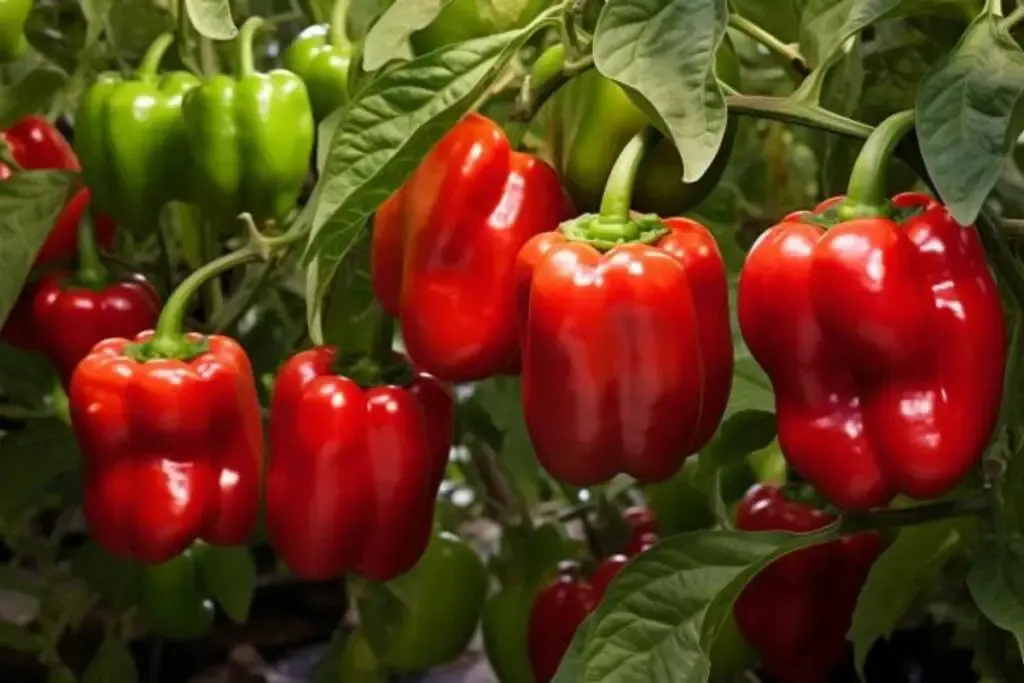
This is a classic bell pepper variety that’s known for its reliability and excellent flavor. The peppers are large and blocky and turn from green to red as they mature.
They have a crisp, sweet taste and are great for stuffing. For gardeners looking for a straightforward and rewarding experience, California Wonder is the way to go.
2. Purple Beauty
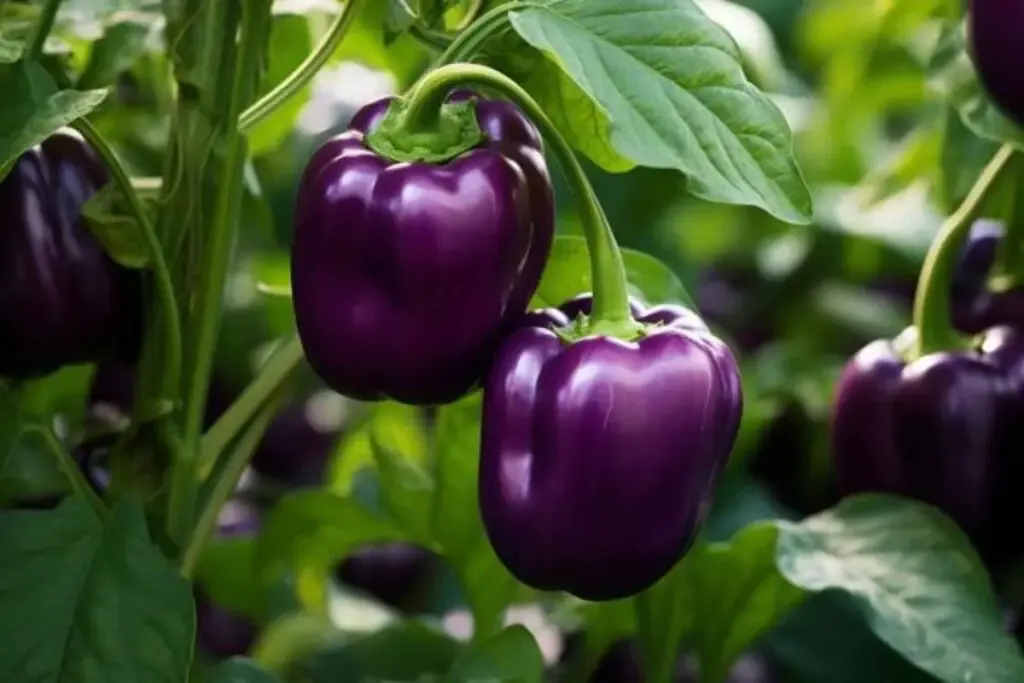
If you’re looking to add some unusual color to your garden, Purple Beauty is an excellent choice. These peppers start as a deep, striking purple and mature to a rich red.
They have a slightly sweeter taste compared to the green varieties and are a favorite in salads for their color and flavor.
3. Sweet Banana
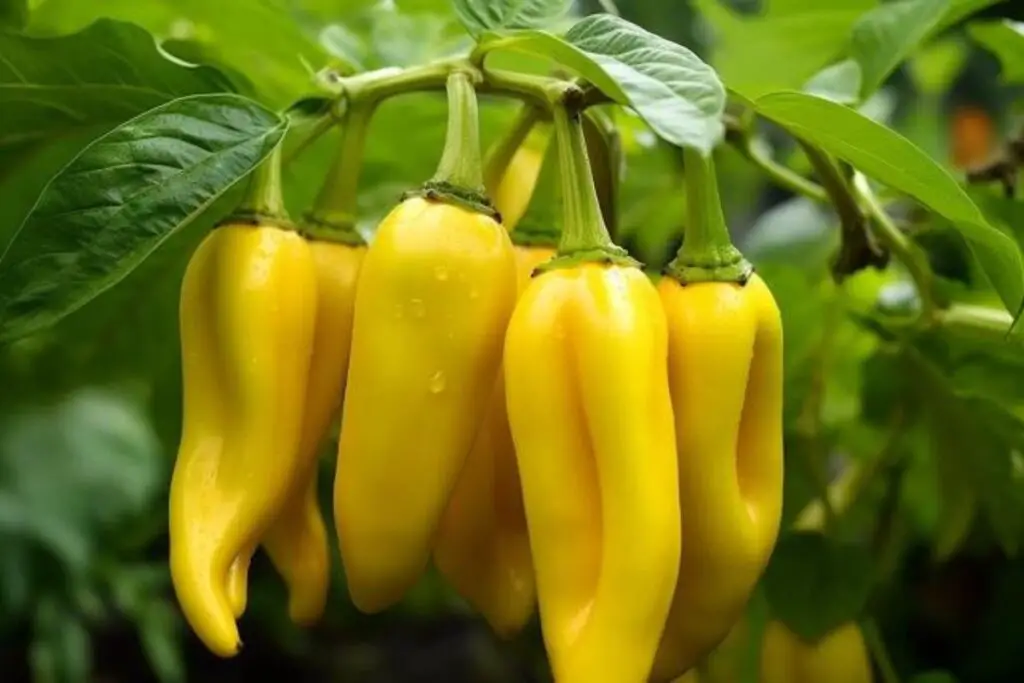
This variety produces long, banana-shaped peppers that are excellent for frying and salads. They start out light yellow and mature to a bright red, offering a sweet and tangy flavor.
Sweet Banana peppers are particularly known for their high yield and ease of growing, making them a favorite among many gardeners.
Bell Pepper Care
Caring for bell peppers is a delightful and rewarding process. With the right attention and conditions, you can grow robust plants that produce bountiful and delicious peppers.
Let’s break down the essential care steps for your bell pepper plants.
Planting
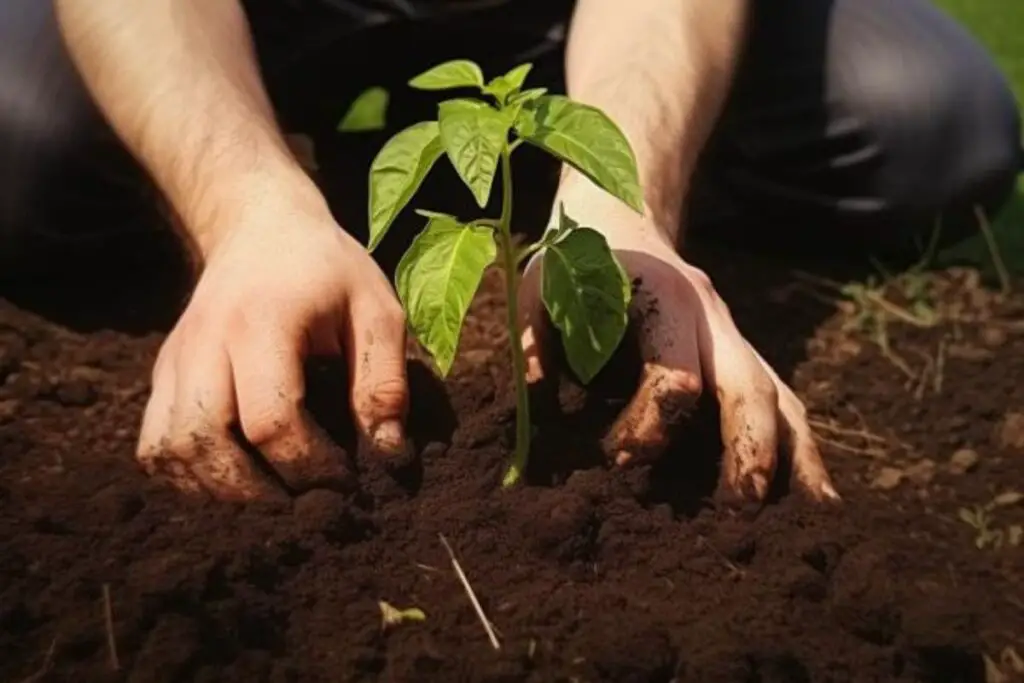
Planting bell peppers starts with either seeds or seedlings. If you’re starting from seeds, begin indoors about 8-10 weeks before the last frost date.
Transplant the seedlings outdoors when the danger of frost has passed and nighttime temperatures are consistently above 55°F.
Space the plants about 18 to 24 inches apart in rows that are 24 to 36 inches apart. This spacing allows adequate air circulation and room for growth.
Light
Bell peppers love the sun. They need full sunlight to produce the largest and healthiest fruits. Aim for at least 6-8 hours of direct sunlight daily.
If you’re growing peppers in a region with very intense sun, a bit of afternoon shade can help protect them.
Soil
Well-draining, fertile soil is key for growing bell peppers. They prefer a slightly acidic to neutral pH, around 6.0 to 6.8.
Before planting, enrich the soil with compost or aged manure to improve fertility and drainage.
Water
Consistent watering is crucial for bell peppers. They require a steady supply of moisture for steady growth but don’t do well in soggy soil.
Aim for about 1 to 2 inches of water per week, adjusting based on rainfall and temperature. Mulching around the plants can help retain soil moisture and keep the roots cool.
Temperature and Humidity
Bell peppers thrive in warm, moderate climates. They grow best when daytime temperatures are between 70°F and 85°F and nighttime temperatures don’t drop below 55°F.
They can tolerate a bit of humidity but might struggle in very hot and dry or overly humid conditions.
Fertilizer
Bell peppers are moderate feeders. A balanced, slow-release fertilizer applied at planting and again when the fruits begin to form can support healthy growth.
Use a fertilizer with equal parts nitrogen, phosphorus, and potassium (such as a 10-10-10 formula). Be careful not to over-fertilize, as this can promote more foliage growth at the expense of fruit production.
Harvesting Bell Peppers
Harvesting bell peppers is an exciting part of the growing process. The timing of the harvest depends on the color and size you prefer.
Generally, peppers can be picked when they are firm and have reached their full size, usually about 60-90 days after planting.
The color will change from green to red, yellow, orange, or purple, depending on the variety, as they mature.
Use a sharp knife or scissors to cut the pepper from the plant, leaving a short amount of stem attached. Regular harvesting encourages the plant to produce more fruits.
Pruning
Pruning is not usually necessary for bell peppers, but it can help the plant focus its energy on producing fruits.
If you choose to prune, do so early in the season by removing the lowest branches to encourage air circulation and reduce the risk of soil-borne diseases.
Additionally, pinching off the early flowers can help the plant to grow larger and stronger before it starts fruiting.
Propagating
Bell peppers are typically grown from seeds and are not commonly propagated by cuttings. To propagate bell peppers, you would save seeds from a mature pepper and plant them.
Make sure to use seeds from open-pollinated or heirloom varieties, as hybrid seeds may not produce true-to-type plants.
How to Grow Bell Peppers From Seed
Growing bell peppers from seed is a rewarding process. Start seeds indoors about 8-10 weeks before the last expected frost.
Plant the seeds in a seed-starting mix, about a quarter inch deep, and keep the soil moist and warm (around 80°F). Once seedlings emerge, provide plenty of light to prevent leggy growth.
Harden off the seedlings by gradually exposing them to outdoor conditions before transplanting them outdoors after all danger of frost has passed.
Growing in Pots
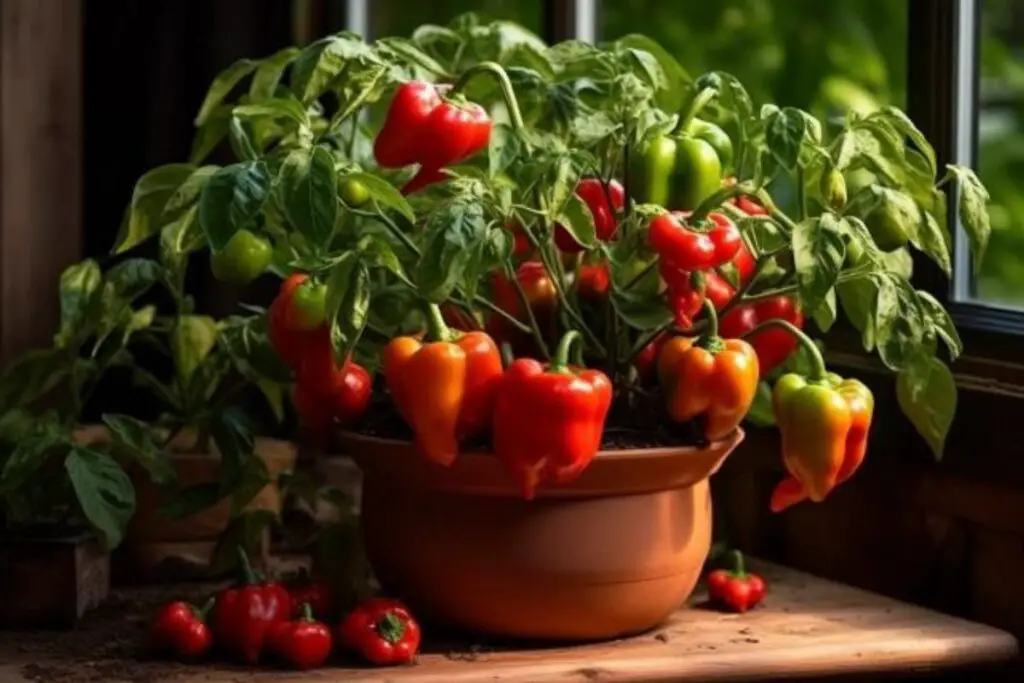
Bell peppers are well-suited for container gardening. Choose a pot that is at least 12 inches deep and has good drainage.
Use a high-quality potting mix and plant one pepper plant per pot. Place the pot in a sunny location and water regularly, keeping the soil consistently moist but not waterlogged.
Container-grown peppers may need more frequent watering and fertilization than those grown in the ground.
Overwintering
Overwintering bell peppers can be a bit challenging, as they are not frost-tolerant. However, in milder climates, you can overwinter mature plants by heavily mulching around the base to protect the roots from light frosts.
In colder regions, it’s best to treat bell peppers as annuals and plant new ones each year. Alternatively, if you’ve grown peppers in pots, you can bring them indoors during the winter months, placing them in a sunny window or under grow lights to keep them alive.
Transplanting
Transplanting bell peppers is a crucial step, especially when moving them from indoors to the garden. The key is to do it without disturbing their roots too much.
Harden off the seedlings gradually over a week, increasing their exposure to outdoor conditions. When transplanting, be gentle and try to keep the root ball intact.
Transplant on a cloudy day or in the late afternoon to reduce stress on the plants. Water them well after transplanting to help them settle in their new home.
Common Pests & Diseases
Bell peppers can be susceptible to a variety of pests and diseases. Common pests include aphids, spider mites, and cutworms, which can be controlled with insecticidal soap or neem oil.
Diseases like bacterial spot, blossom end rot, and mildew can also affect bell peppers. To prevent these, ensure good air circulation, avoid overhead watering, and practice crop rotation.
If diseases do appear, use appropriate fungicides and remove any affected plants to prevent spreading.
Remember, growing bell peppers is not just about adding flavor to your dishes; it’s about adding color, nutrition, and joy to your life.
As you nurture these vibrant plants, they’ll reward you with a bounty of fresh, delicious peppers. Happy pepper growing!

